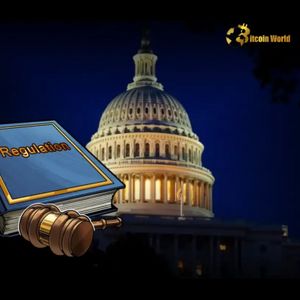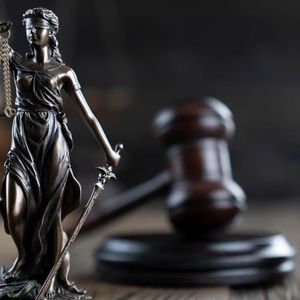US Crypto Regulation: House Unveils Critical Digital Asset Bill Update
6 min read
BitcoinWorld US Crypto Regulation: House Unveils Critical Digital Asset Bill Update The landscape of finance is constantly evolving, with digital assets like cryptocurrencies playing an increasingly significant role. For anyone involved in this space, understanding the regulatory environment is paramount. A major development is on the horizon that could dramatically shape US crypto regulation . Reports citing multiple sources indicate that the U.S. House of Representatives is preparing to release an updated version of its comprehensive digital asset bill . This isn’t just a minor tweak; it’s seen as a substantial effort to establish a clear and robust framework for the industry in the United States. What is the US House Crypto Bill Update All About? The upcoming release, reportedly scheduled for May 29, builds upon previous legislative efforts by House Republicans. The core objective remains the same: to provide much-needed clarity on how digital assets should be regulated at the federal level. Currently, the lack of a clear framework creates uncertainty, hindering innovation and potentially exposing consumers to risks. This updated US House crypto bill is expected to be the result of ongoing discussions and feedback from various stakeholders, including industry participants, regulators, and consumer advocates. It signifies a determined push within certain parts of Congress to move beyond debate and towards concrete legislative action. The bill aims to address fundamental questions that have long plagued the industry, such as: Which federal agency has jurisdiction over different types of digital assets? (Is it the SEC, the CFTC, or both?) How should stablecoins be regulated? What rules should apply to cryptocurrency exchanges and other platforms? How can consumer protection be enhanced in the digital asset space? By providing answers to these questions, the bill seeks to lay the foundation for a predictable and safe environment for digital asset innovation and adoption. Why is Clear US Crypto Regulation So Crucial Right Now? The United States is a global leader in financial markets and technological innovation. However, when it comes to digital assets, the regulatory picture has been fragmented and, at times, contradictory. This ambiguity can lead to several problems: Hindered Innovation: Businesses are hesitant to build and invest in the US if they are unsure which rules apply or if those rules might change unpredictably. Investor Uncertainty: Lack of clarity makes it difficult for both retail and institutional investors to understand their rights and the risks involved. Regulatory Turf Wars: Disagreements between agencies like the Securities and Exchange Commission (SEC) and the Commodity Futures Trading Commission (CFTC) create confusion and can result in enforcement actions that the industry perceives as regulation by enforcement. Loss of Competitiveness: Other jurisdictions around the world are moving faster to establish comprehensive frameworks, potentially attracting businesses and talent away from the US. A well-defined crypto framework US could address these issues, fostering a more stable and attractive environment for the digital asset ecosystem. How Might This Bill Impact the Crypto Market Structure? The structure of the crypto market in the US is heavily influenced by regulatory uncertainty. Platforms operate under a patchwork of state and federal guidelines, often facing challenges in determining their compliance obligations. An effective digital asset bill could significantly alter this structure by: Defining Roles: Clearly assigning regulatory authority to specific agencies based on the nature of the digital asset (e.g., whether it functions more like a security or a commodity). This is a key component expected to be addressed in the updated bill. Establishing Registration Pathways: Creating clear processes for crypto platforms to register and operate legally, similar to how traditional financial institutions are regulated. Setting Standards: Introducing federal standards for consumer protection, cybersecurity, and market integrity that all regulated entities must follow. Here’s a simplified look at the potential jurisdictional clarity this bill might aim for, based on ongoing discussions: Type of Digital Asset Function Potential Regulatory Authority Likely Focus Investment Contracts (Securities) SEC (Securities and Exchange Commission) Investor protection, disclosure requirements, anti-fraud measures Commodities (e.g., Bitcoin, Ether based on some views) CFTC (Commodity Futures Trading Commission) Market manipulation, fraud in derivatives markets Payment Stablecoins Potentially new framework involving banking regulators and/or state regulators Reserves, redemption rights, systemic risk Decentralized Protocols Less clear, potentially activity-based regulation Specific activities like lending or trading interfaces (Note: The specific definitions and jurisdictional lines drawn in the actual bill remain to be seen, but these are common areas of discussion.) What Are the Benefits and Challenges of This Crypto Legislation US? Passing significant crypto legislation US is a complex undertaking with potential benefits and significant challenges. Potential Benefits: Enhanced Clarity: Reduces legal and regulatory uncertainty for businesses and investors. Increased Innovation: Provides a clearer path for startups and established companies to develop and deploy digital asset technologies in the US. Stronger Consumer Protection: Implements federal safeguards against fraud, manipulation, and mismanagement. Attracting Capital: Makes the US market more attractive for institutional investors seeking regulatory certainty. Global Competitiveness: Positions the US as a leader in the digital asset space, rather than lagging behind other nations. Regulatory Efficiency: Potentially streamlines oversight by clearly defining agency roles. Potential Challenges: Political Divisions: Achieving bipartisan consensus on such a complex and novel topic can be difficult. Industry Disagreements: Different sectors within the crypto industry have varying views on how they should be regulated. Regulatory Turf Battles: Existing agencies may resist changes to their perceived authority. Pace of Technology: Legislation can struggle to keep up with the rapid evolution of digital asset technology. Defining Digital Assets: Reaching agreement on how to classify the vast array of digital assets is inherently complex. The success of this updated digital asset bill will depend on its ability to navigate these challenges effectively while providing a framework that is both protective and conducive to innovation. What Happens After the Bill is Released? The release of the updated bill on May 29 is just one step in a long legislative process. Here’s a likely path forward: Public Review and Feedback: The bill will be made public, allowing industry participants, experts, and the public to analyze its provisions and provide feedback. Committee Markup: The relevant House committees (likely the House Financial Services Committee and potentially the House Agriculture Committee) will hold hearings and markups, where they will debate, amend, and vote on the bill. House Floor Vote: If approved by the committees, the bill would then need to be scheduled for a vote by the full House of Representatives. Senate Consideration: If passed by the House, the bill would move to the Senate, where it would go through a similar process of committee review and potential floor votes. Conference Committee (If Needed): If the House and Senate pass different versions of the bill, a conference committee would be formed to reconcile the differences. Presidential Signature: If both chambers pass the same version, it goes to the President for signature to become law. This process can take months, or even years, and there’s no guarantee that the bill will ultimately become law in its current form, or at all. However, the release marks significant progress in the ongoing effort to establish comprehensive US crypto regulation . Actionable Insight: Stay Informed For anyone operating or investing in the digital asset space, the most crucial actionable insight right now is to stay informed. Follow reliable news sources, read analyses of the bill once it’s released, and understand how its provisions could impact specific assets or platforms you use. Engaging with industry associations or contacting your representatives can also be ways to make your voice heard as the legislative process unfolds. The future crypto market structure in the US depends on the outcome of these legislative efforts. Summary: A Key Step Towards a US Crypto Framework The impending release of the updated digital asset bill by the U.S. House of Representatives on May 29 is a pivotal moment in the quest for clear US crypto regulation . Building on previous drafts, this legislation aims to provide a much-needed federal framework, addressing critical issues like agency jurisdiction, asset classification, and consumer protection. While the path to becoming law is long and fraught with potential challenges, this bill represents a significant step forward in establishing a predictable and supportive crypto framework US . The industry and market participants will be closely watching the details of this updated US House crypto bill as it emerges, hopeful that it will pave the way for a more certain and innovative future for digital assets in America. To learn more about the latest crypto legislation US trends, explore our article on key developments shaping the crypto market structure and US crypto regulation. This post US Crypto Regulation: House Unveils Critical Digital Asset Bill Update first appeared on BitcoinWorld and is written by Editorial Team

Source: Bitcoin World



